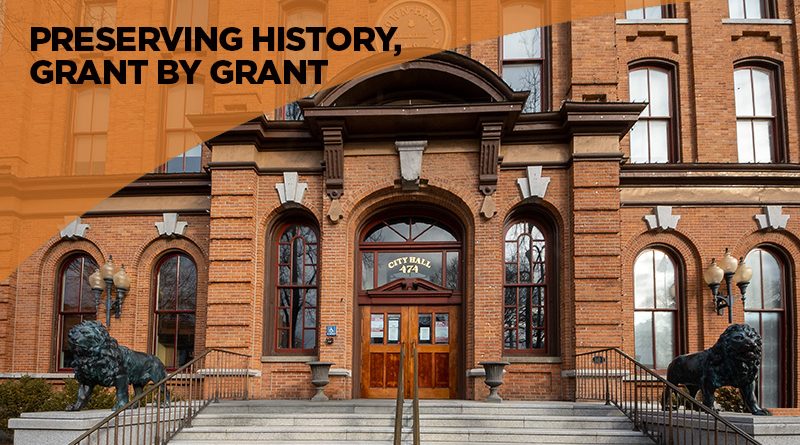Historic Preservation: Remember Our Roots and Look to the Future
Historic Preservation. Have you ever stopped to consider this phrase? What it means? Why the concept is so important? The reality is that most of us don’t pay attention to historic preservation. As a philosophy, it is a set of actions that are vital to maintaining links us to our diverse cultures and unique heritages. As an actionable practice, it means knowing that the act of preserving our past leads to a stronger future.
Historic Preservation helps us find and maintain our diverse cultural identities. After all, isn’t our country built on the shared dreams and ideals of people who sensed a greater need for community and the common good? Logically, the final question must be, how do we fund historic preservation projects?
GrantWatch takes great pride in providing access to a variety of grants to help fulfill this essential obligation we share in preserving our cultural diversity. Grant funding is available to help with things like restoring landmark buildings, protecting historic homes, and preserving historically significant sites. In addition, funding can also lead to community development, the collection of oral histories, and sustaining heritage properties.
Importance of Historical Preservation
Historic preservation is a conversation with our past about our future. It provides us with opportunities to ask, “What is important in our history?” and “What parts of our past can we preserve for the future?” Through historic preservation, we look at history in different ways, ask different questions of the past, and learn new things about our history and ourselves. Historic preservation is an important way for us to transmit our understanding of the past to future generations.
Our nation’s history has many facets, and historic preservation helps tell these stories. Sometimes historic preservation involves celebrating events, people, places, and ideas that we are proud of; other times it involves recognizing moments in our history that can be painful or uncomfortable to remember.
Within the National Park Service, many people work in historic preservation: archeologists, architects, curators, historians, landscape architects, and other cultural resource professionals. The National Park Service carries out historic preservation both within and outside the National Park System.
National Park Service, “What is Historic Preservation?“
Below is a list from GrantWatch from its Historic Preservation category of grants currently available.
Historic Preservation Grants and Tax Credits
- First, funding for nonprofits, IHEs, and government agencies for small capital projects at sites with historic significance throughout the state. Furthermore, funding helps restore, preserve, and rehabilitate historic buildings.
- There are also grants of up to $10,000 and up to $50,000 to nonprofit organizations and individuals. Funding is for the preservation of culturally and historically significant sites in eligible areas.
- In addition, grants to nonprofits and public organizations in eligible locations to enhance the local community. What’s more, focus areas include education, arts, economic development, and historic preservation.
- Also, grants to nonprofits, IHEs, government agencies, and Tribal governments for the preservation of humanities-materials. Funding is for the planning and implementation of sustainable conservation measures to mitigate deterioration and prolong the life of collections. Goals are also to reduce energy consumption and strengthen the ability of institutions to anticipate and respond to disasters.
- Last, grants of up to $5,000 to nonprofits and government agencies for community programs that focus on health, human services, arts and culture, community development, and historic preservation.
Additional Historic Preservation Grants
- Grants of up to $10,000 to nonprofits and government agencies for historic preservation and protection projects. Funding is for projects in the following focus areas: buildings and structures, collections and artifacts, and oral history. In addition, project focus areas also include: historic cemeteries and sacred sites, and outreach and project development. Projects are to make significant contributions to the preservation and interpretation of area history.
- There are grants of up to $10,000 and in-kind support to scholars representing Indigenous communities for efforts to record, preserve, and revitalize Indigenous cultures, languages, and knowledge systems. Further, funding increases access to diverse collections – archival, biological, and cultural – and supporting research.
- Next, funding and in-kind donations to nonprofit organizations, groups, and businesses to conserve, protect, and restore important wildlife habitats in ponds, rivers, swamps, wetlands, and streams.
- In addition, there are grants to eligible nonprofits, municipalities, and academic institutions to help document/publicize/celebrate local history. Funding is to help encourage tourism and economic development.
- To conclude, grants of up to $25,000 to property owners, municipalities, nonprofits, and associations to preserve historically significant properties. Funding is for research, planning, capital projects, long-term maintenance, and education. Finally, the goal is the conservation and long-term sustainability of heritage properties.
We hope you’ll find a way to utilize a grant to preserve some part of history for your community!
About GrantWatch
With close to 8,000 grants currently available, GrantWatch.com is the leading grant listing directory. Upgrade to a MemberPlus+ subscription to view the full grant details, including eligibility criteria and application information. For more information, you can also visit the GrantWatch FAQ page. so, to see the great value of all 20 of the top GrantWatch features, click here.
GrantWatch does not guarantee this information will lead to a grant.

